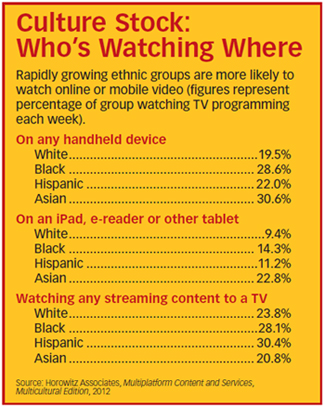Over-the-Top Platforms Shake Up Ethnic Market

The debates over the long-term impact of over-the-top content have been producing much heat and very little light. While some have argued that OTT heralds the end of the traditional TV business, others note that there is little data to support this doomsday scenario, given that TV viewing and pay TV subscriptions remain at all-time highs.
Beyond the speculation, however, a fascinating glimpse into how OTT content would transform an industry can already be found in the distribution of ethnic content to Internet-connected devices.
Adriana Waterston, VP of marketing and business development at Horowitz Associates, says ethic communities are particularly important because they are the fastest-growing groups in America, and because they tend to have younger populations that watch significantly more OTT content. “When you are thinking about the marketplace of tomorrow, you have to be thinking about multicultural consumers,” Waterston says. “They’re on the leading edge of using technologies.”
That has already produced a rush to deliver OTT content for the ethnic market. Dish Network recently announced a major alliance with Roku to offer a variety of international content on Roku boxes; Globecast launched an ambitious OTT service called MyGlobeTV; and several start-ups have appeared, including Internet Broadcast Corp., which just closed financing for the launch of a Vibble TV service with 60-plus South Asian channels.
Suresh Bala Iyer, CEO of Asia TV USA, notes that IP delivery is much less costly than traditional satellite distribution, which has helped boost the number of Indian channels in the U.S. from 25 in 2009 to 110 today. Of the 19 services operated by Asian TV, 10 are offered via broadband.
Bala estimates that the broadband services have captured around 250,000 subs, or about 40% of the South Asian marketplace, while subscribers to these services on traditional pay TV platforms have not grown. “It is the fastest-growing area of the market,” Bala says.
That is putting pressure on more traditional pay models. Globecast launched its direct-to-home satellite service, World TV, with a wide array of international content in 1987; this summer, the company introduced a broadband service, MyGlobeTV. “We had seen subscriber losses because of competition from the OTT space, and MyGlobeTV is a natural progression in our offerings” that will give users an array of broadband content and provide programmers with a less-expensive way to enter the U.S. market, explains Emma Brackett, VP of consumer video products and services at GlobeCast.
Dish, the largest pay TV provider of international and ethnic services in the U.S., formed a wide-ranging alliance with Roku to supply international content. Jim Funk, Roku senior VP of product management, notes that the agreement will help the company expand its international content. The deal will enable Dish to reach customers in apartment blocks or urban areas without satellite service accessibility.
Other operators have been bee! ng up the amount of ethnic content they offer via TV Everywhere platforms. AT&T this year cut a groundbreaking TV Everywhere deal with Univision that will eventually allow authenticated subscribers to access live streams of Univision networks.
Andy Goodman, AT&T director of broadband content, says the deal is part of a larger strategy to expand the company’s TV everywhere offerings and that AT&T is in the process of completing additional deals with ethnic programmers.
Telemundo, meanwhile, has also made TV Everywhere alliances a priority as a way to target Hispanic viewers who are heavy users of mobile and online video. Peter E. Blacker, executive VP of digital media and emerging businesses at Telemundo, says they are making additional content available to authenticated subscribers and have been delivering a record amount of Spanish-language coverage of the Olympics as part of the TV Everywhere deals. “It is one of the biggest TV Everywhere authenticated experiences to date,” Blacker says.
In the wake of these developments, pirated broadband feeds of international networks have emerged as a major problem, in part because multichannel operators have been slow to respond to market demands for more content on multiple devices.
“The truth is that there is a lot of talk about delivering TV Everywhere,” says Bala. “We are ready to do it, but we have not seen a lot of action.”
E-mail comments to gpwin@oregoncoast.com and follow him on Twitter: @GeorgeWinslow
Broadcasting & Cable Newsletter
The smarter way to stay on top of broadcasting and cable industry. Sign up below
